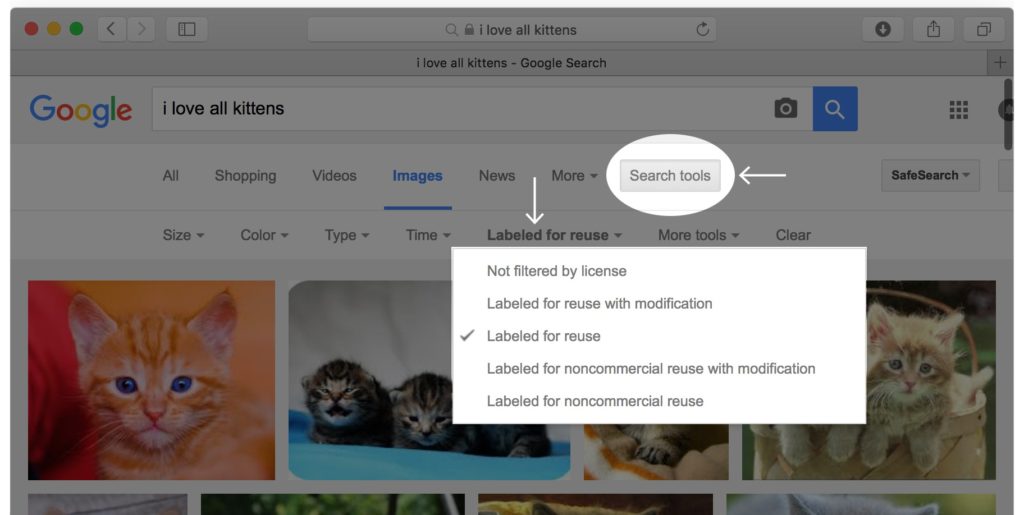If you’re like me then you wear glasses, have a closet full of plaid shirts, and are only on season one of Game of Thrones. More importantly, if you’re like me you’ve spent countless hours scrolling through stock photography websites looking for that perfect photo for your client’s ad, website, logo, promo item, etc.

Stock sites can have really useful, robust search features, but at times the allure of a Google image search can be quite powerful. It can be so easy to slide on over to Google and type-ity-type a few thoughts into the search bar to find exactly what you’re looking for. But be warned! Google brings you everything it can find. Not just the images you’re allowed to use.
So, What’s the Problem?
A Google image search will certainly bring you all you desire served up right on a silver platter and everything—especially if you google “things on a silver platter.” But, if you’re looking to manipulate an image, or use it to sell your services or product, then it’s imperative you find out whether that image is licensed for such a purpose. Luckily, Google has a Usage Rights filter tucked underneath the Search Tools dropdown. Here you can select from a list of four options for varying degrees of reuse. This is a great start, but it doesn’t always mean those images are free of all copyright restrictions. You’ll still need to do a bit more digging.

Understanding Copyright
Once a person creates something, like a photo, illustration, or song, it’s automatically protected under copyright laws, provided it’s original content. The FAQ over at copyright.gov puts it this way: “Your work is under copyright protection the moment it is created and fixed in a tangible form that it is perceptible either directly or with the aid of a machine or device.” That’s great news for all of us creators but it can be difficult to enforce online. Here’s a common problem: Let’s say I took a photo of my impressive stuffed animal collection. I want to share that picture online because I put a lot of work into the staging, costumes, and lighting. I really want people to see, and even share, my incredible talent, but I don’t want someone getting super rich by perpetrating themselves as the real talent behind the animal collecting and photography. How do I define clear, legal rules on how I will and will not allow a person to use this photo? From a user’s perspective it can be difficult to tell if an image is free to use or not.
Creative Commons Licenses
With published works it’s easier to understand where the line is drawn. We all know we can’t open up a Danielle Steel book and take exact wording from it to use in our own book. Or use scenes from Howard The Duck in your own film. Not without getting permission, (and probably) paying a decent amount of money, and making proper notations in credits or footnotes. Even then it can be hard to follow the rules to the letter. The reality is, most of us aren’t pumping out popular books or making blockbuster films, but are instead writing blogs, creating content for social media, and generally trying to be heard over the constant din of the internet. This is where the Creative Commons license comes in handy. Creative Commons is a non-profit organization that works in tandem with copyright laws to give the public more freedom to use shared works. CC developed a system of licenses and uses a set of icons and simple wording so creators can tag and share their work so it’s used exactly how they want it to be used. You can get all of the details at CreativeCommons.org. So when the owner of a local coffee shop writes a rousing post on roasting methods, she can more easily determine if an image she found on Flickr is OK to use as a header on her website’s blog. This system works to protect and benefit the licensor and licensee alike.
Don’t Be a Cheapskate
Even with CC licenses and copyright laws, you can still find yourself teetering on a precipice, trying to determine if you are allowed to use an image, song, or video clip.
Beyond that, there is one way you can almost be certain you can use someone’s creative property for your own work: Pay them for it. If you’re looking for a photo or illustration, hire someone to make it for you and work with them to get the results you’re looking for. Just make sure you get contracts signed and you obtain written versions of licenses and usage agreements. If you don’t have the time or resources to work directly with a professional, there’s a bunch of really great sources online for things like photography, original illustration, video, or audio. Shutterstock, iStock, Offset, AudioJungle, Musicbed and Video Helper are a few that come to mind.
Get out there and create!
